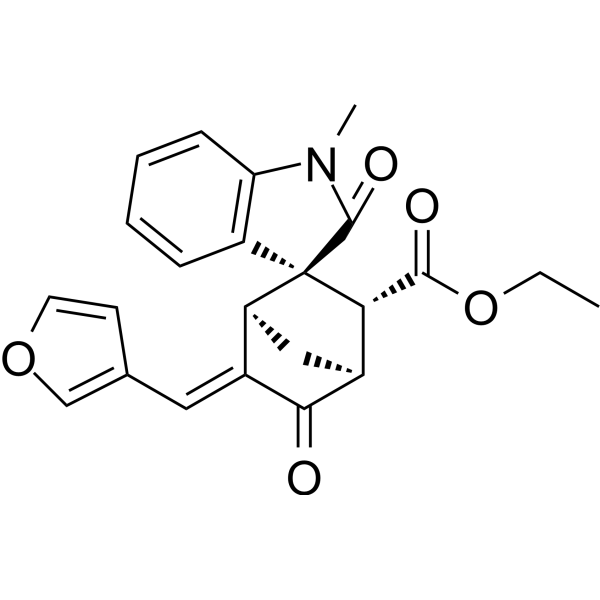Physicochemical Properties
| Molecular Formula | C23H21NO5 |
| Molecular Weight | 391.42 |
| CAS # | 2070916-70-8 |
| Appearance | White to light brown solid powder |
| HS Tariff Code | 2934.99.9001 |
| Storage |
Powder-20°C 3 years 4°C 2 years In solvent -80°C 6 months -20°C 1 month |
| Shipping Condition | Room temperature (This product is stable at ambient temperature for a few days during ordinary shipping and time spent in Customs) |
Biological Activity
| ln Vitro | In live cells, PPI-GIT1/β-Pix interaction-IN-1 (compound 14-5-18; 0-50 μM) suppresses the interaction between GIT1 and β-Pix [1]. The dose-dependent inhibition of gastric cancer cell invasion is achieved by PPI-GIT1/β-Pix interaction-IN-1 (0-50 μM; 24 hours; MGC803 cells and MKN45 cells), and the downstream Rho GTPases Rac1 and Cdc42 are impacted by the disruption of the GIT/PIX interaction[1]. |
| ln Vivo | In MGC803 xenograft female nude mice, PPI-GIT1/β-Pix interaction-IN-1 (compound 14-5-18; 10 and 30 mg/kg; ir; 24 h) suppresses the invasion of gastric cancer cells [1]. |
| Cell Assay |
Western Blot Analysis[1] Cell Types: MGC803 cells and MKN45 cells Tested Concentrations: 0, 5, 20, and 50 μM Incubation Duration: 24 hrs (hours) Experimental Results: Suppressed the expression of GTP-Rac1 and GTP-Cdc42 in a dose-dependent manner. |
| Animal Protocol |
Animal/Disease Models: Female nude mice with MGC803 xenografts (Fourweeks old)[1] Doses: 10 and 30 mg/kg Route of Administration: po (oral gavage), daily, for 18 days Experimental Results: decreased the luminescence intensity in the lungs in a dose- dependent manner. |
| References |
[1]. Construction of a synthetic methodology-based library and its application in identifying a GIT/PIX protein-protein interaction inhibitor. Nat Commun. 2022 Nov 23;13(1):7176. |
Solubility Data
| Solubility (In Vitro) | May dissolve in DMSO (in most cases), if not, try other solvents such as H2O, Ethanol, or DMF with a minute amount of products to avoid loss of samples |
| Solubility (In Vivo) |
Note: Listed below are some common formulations that may be used to formulate products with low water solubility (e.g. < 1 mg/mL), you may test these formulations using a minute amount of products to avoid loss of samples. Injection Formulations (e.g. IP/IV/IM/SC) Injection Formulation 1: DMSO : Tween 80: Saline = 10 : 5 : 85 (i.e. 100 μL DMSO stock solution → 50 μL Tween 80 → 850 μL Saline) *Preparation of saline: Dissolve 0.9 g of sodium chloride in 100 mL ddH ₂ O to obtain a clear solution. Injection Formulation 2: DMSO : PEG300 :Tween 80 : Saline = 10 : 40 : 5 : 45 (i.e. 100 μL DMSO → 400 μLPEG300 → 50 μL Tween 80 → 450 μL Saline) Injection Formulation 3: DMSO : Corn oil = 10 : 90 (i.e. 100 μL DMSO → 900 μL Corn oil) Example: Take the Injection Formulation 3 (DMSO : Corn oil = 10 : 90) as an example, if 1 mL of 2.5 mg/mL working solution is to be prepared, you can take 100 μL 25 mg/mL DMSO stock solution and add to 900 μL corn oil, mix well to obtain a clear or suspension solution (2.5 mg/mL, ready for use in animals). Injection Formulation 4: DMSO : 20% SBE-β-CD in saline = 10 : 90 [i.e. 100 μL DMSO → 900 μL (20% SBE-β-CD in saline)] *Preparation of 20% SBE-β-CD in Saline (4°C,1 week): Dissolve 2 g SBE-β-CD in 10 mL saline to obtain a clear solution. Injection Formulation 5: 2-Hydroxypropyl-β-cyclodextrin : Saline = 50 : 50 (i.e. 500 μL 2-Hydroxypropyl-β-cyclodextrin → 500 μL Saline) Injection Formulation 6: DMSO : PEG300 : castor oil : Saline = 5 : 10 : 20 : 65 (i.e. 50 μL DMSO → 100 μLPEG300 → 200 μL castor oil → 650 μL Saline) Injection Formulation 7: Ethanol : Cremophor : Saline = 10: 10 : 80 (i.e. 100 μL Ethanol → 100 μL Cremophor → 800 μL Saline) Injection Formulation 8: Dissolve in Cremophor/Ethanol (50 : 50), then diluted by Saline Injection Formulation 9: EtOH : Corn oil = 10 : 90 (i.e. 100 μL EtOH → 900 μL Corn oil) Injection Formulation 10: EtOH : PEG300:Tween 80 : Saline = 10 : 40 : 5 : 45 (i.e. 100 μL EtOH → 400 μLPEG300 → 50 μL Tween 80 → 450 μL Saline) Oral Formulations Oral Formulation 1: Suspend in 0.5% CMC Na (carboxymethylcellulose sodium) Oral Formulation 2: Suspend in 0.5% Carboxymethyl cellulose Example: Take the Oral Formulation 1 (Suspend in 0.5% CMC Na) as an example, if 100 mL of 2.5 mg/mL working solution is to be prepared, you can first prepare 0.5% CMC Na solution by measuring 0.5 g CMC Na and dissolve it in 100 mL ddH2O to obtain a clear solution; then add 250 mg of the product to 100 mL 0.5% CMC Na solution, to make the suspension solution (2.5 mg/mL, ready for use in animals). Oral Formulation 3: Dissolved in PEG400 Oral Formulation 4: Suspend in 0.2% Carboxymethyl cellulose Oral Formulation 5: Dissolve in 0.25% Tween 80 and 0.5% Carboxymethyl cellulose Oral Formulation 6: Mixing with food powders Note: Please be aware that the above formulations are for reference only. InvivoChem strongly recommends customers to read literature methods/protocols carefully before determining which formulation you should use for in vivo studies, as different compounds have different solubility properties and have to be formulated differently. (Please use freshly prepared in vivo formulations for optimal results.) |
| Preparing Stock Solutions | 1 mg | 5 mg | 10 mg | |
| 1 mM | 2.5548 mL | 12.7740 mL | 25.5480 mL | |
| 5 mM | 0.5110 mL | 2.5548 mL | 5.1096 mL | |
| 10 mM | 0.2555 mL | 1.2774 mL | 2.5548 mL |
